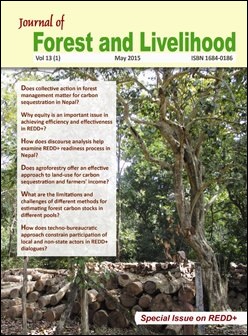Agro-forestry Systems as a Means to Achieve Carbon Co-benefits in Nepal
DOI:
https://doi.org/10.3126/jfl.v13i1.15366Keywords:
Above ground biomass, Soil carbon stock, Leasehold forest, Community forestAbstract
Land management regimes and forest types play an important role in the productivity and accumulation of terrestrial carbon pools. While it is commonly accepted that forests enhance carbon sequestration and conventional agriculture causes carbon depletion, the effects of agro-forestry are not well documented. This study investigated the carbon stocks in biomass and soil, along with the selected soil properties in agro-forestry plots compared to community forests (CF) and upland farms in Chitwan, Gorkha and Rasuwa districts of Central Nepal during the year 2012-2013. We determined the total above ground biomass carbon, soil organic carbon (SOC) stocks and soil properties (bulk density, organic carbon per cent, pH, total nitrogen (TN), available phosphorus (P), exchangeable potassium (K), and cation exchange capacity (CEC)) on samples taken from four replicates of 500 m2 plots each in community forests, agro-forestry systems and agricultural land. The soil was sampled in two increments at 0-15 cm and 15-30 cm depths and intact cores removed for bulk density and SOC determination, while loose samples were separately collected for the laboratory analysis of other soil properties. The mean SOC percent and corresponding soil carbon stocks to 30 cm depth were generally highest in CF (3.71 and 3.69 per cent, and 74.98 and 76.24 t ha-1, respectively), followed by leasehold forest (LHF) (2.26 and 1.13 per cent and 40.72 and 21.34 t ha-1, respectively) and least in the agricultural land (3.05 and 1.09 per cent, and 63.54 and 19.42 t ha-1, respectively). This trend was not, however, observed in Chitwan, where agriculture (AG) had the highest SOC content (1.98 per cent) and soil carbon stocks (42.5 t ha-1), followed by CF (1.8 per cent and 41.2 t ha-1) and leasehold forests (1.56 per cent and 35.3 t ha-1) although the differences were not statistically significant. Other soil properties were not significantly different among land use types with the exceptions of pH, total N, available P and CEC in the Chitwan plots. Typically, SOC and soil carbon stocks (to 30cm depth) were positively correlated with each other and with TN and CEC. The AGB-C was expectantly highest in Rasuwa district CF (ranging from 107.3 to 260.3 t ha-1) due to dense growth and cool climate, followed by Gorkha (3.1 to 118.4 t ha-1), and least in Chitwan (17.6 to 95.2 t ha-1). The highest C stocks for agro-forestry systems in both above ground and soil were observed in Rasuwa, followed by Chitwan district. Besides forests, agro-forestry systems also hold good potential to store and accumulate carbon, hence they have scope for contributing to climate change mitigation and adaptation with co-benefits.
Journal of Forest and Livelihood 13(1) May, 2015, page: 56-68
Downloads
Downloads
Published
How to Cite
Issue
Section
License
CC-BY-NC: This license allows reusers to distribute, remix, adapt, and build upon the material in any medium or format for noncommercial purposes only, and only so long as attribution is given to the creator.





